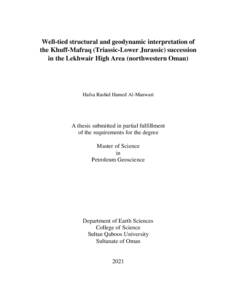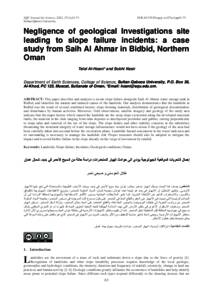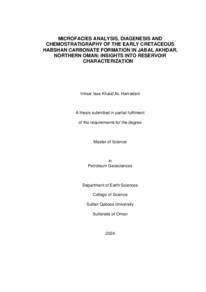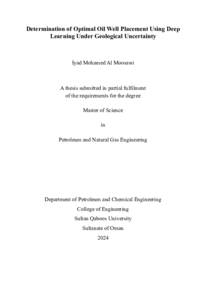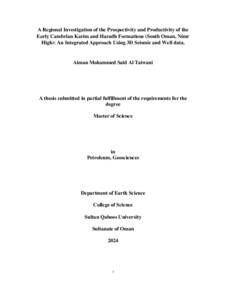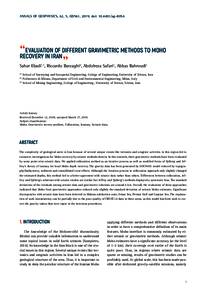Document
Well-tied structural and geodynamic interpretation of the Khuff-Mafraq (Triassic-Lower Jurassic) succession in the Lekhwair High Area (northwestern Oman).
Publisher
Sultan Qaboos University.
Gregorian
2021
Language
English
Subject
English abstract
The Lekhwair High Area is one of the most important hydrocarbon producers in
north Oman. It is situated in the northeastern part of the PDO's concession area, close to the
borders with the United Arab Emirates and Saudi Arabia. Structurally, it is an uplifted zone
located in the foreland of the Oman Mountains. The main regional tectonic events during the
Mesozoic to Cenozoic are represented by two stages of deformation. The Late Cretaceous,
"Alpine 1" phase, characterized by an overall transtrensional regime forming NNW/SSE and
WNW/ESE-oriented faults developed under a NW/SE-direction of maximum horizontal
compression. This phase occurred in association with two ophiolite obductions (Semail and
Masirah ophiolites). The Eocene "Alpine 2" phase is characterized by a NE/SW-directed
transpressional to compressional regime. This phase is associated with the continental
collision of Arabia and Eurasia and the formation of the Zagros Fold-and-thrust belt as well
as the uplift of the Oman Mountains.
The Triassic-Jurassic structures in the Lekhwair Area were previously poorly detected and
very challenging to identify because of the covering of Cenozoic rocks. Hence, these
structures were previously only studied by low-quality seismic data. Petroleum Development
Oman (PDO) recently acquired high-resolution 3D seismic data from northern Oman. The
new data enable the investigation and observation of syn/post-Mesozoic subtle structures.
This study aims to get a better structural characterization of Triassic and Jurassic intervals in
the Lekhwair High Area and support the understanding of the structural/geodynamic
evolution of the Early to Mid-Mesozoic intervals as a grounding for the overlying Cretaceous
reservoirs.
I have observed different fault sets in the study area. (1) NE/SW-oriented reverse faults
developed under NW/SE compression (Alpine 0 compression) during the Late Cretaceous.
The compression caused a local inversion of the pre-existing NE/SW Jurassic extensional
faults and initiation of compressional folds in the Cretaceous overburden. The Cretaceous
stress field was characterized by a horizontal, NW-SE shortening direction (σ1 = σHmax)
and a vertical direction of the minimum stress component (σ3 = σV). During this period, the
kinematic setting of the Indian Plate with regards to the Arabian Plate became inverted. The
southeast-ward directed movement of the Indian Plate during the Early Jurassic (170 to 150
vi
Ma) was followed by northwest-ward motion with anticlockwise rotation of the Indian Plate
during the Late Cretaceous.
(2) A NNW-SSE and WNW-SE conjugate fault set that developed as a transtensional fault
pattern resulting from the first stage of Alpine deformation which occurred during the Late
Cretaceous. This period was associated with two ophiolite obduction stages (Semail and
Masirah ophiolites). The stress field is characterised by a maximum vertically stress
orientation (σ1 = σV) and a NW-SE- directed shortening. The conjugate faults forming
WNW alignments with a left-stepping arrangement (dextral strike slip tendency) and NNW
alignments with a right-stepping arrangement (sinistral stike-slip tendency), respectively.
The "Alpine 1" deformation phase persisted until the Early Palaeocene (65 Ma).
Member of
Resource URL
Arabic abstract
منطقة الخوير العالية هي واحدة من أهم مناطق إنتاج النفط والغاز في شمال عمان. تقع منطقة الخوير في الجزء الشمالي الشرقي من منطقة امتياز شركة تنمية نفط عمان، بالقرب من حدود دولة الإمارات العربية المتحدة. من الناحية التركيبية، فهي منطقة مرتفعة تقع في مقدمة جبال عمان. عادة ما توصف الاحداث التكتونية اإلقليمية الرئيسية خالل فترة الدهر الوسيط إلى حقب الحياة الحديثة بأنها سلسلة من مرحلتين من التشوه. تتميز المرحلة المتأخرة من العصر الطباشيري، بانزلاق إضراب شامل لنظام التمديد مع أقصى ضغط أفقي باتجاه الشمال الغربي إلى الجنوب الشرقي. حدثت هذه المرحلة بالاشتراك مع اثنين من عروق الأوفيواليت )سمائل ومصيرة(. تتميز مرحلة العصر الفجري بنظام ترانسبرسي باتجاه الشمال الشرقي إلى الجنوب الغربي إلى نظام ضغط. ترتبط هذه المرحلة بالتصادم القاري بين شبه الجزيرة العربية وأوراسيا وتشكيل حزام زاجروس وحزام الدفع باإلضافة إلى ارتفاع جبال عمان. تم اكتشاف الهياكل الثالثية-الجوراسية في منطقة الخوير سابقا بشكل سيء وكان من الصعب تحديدها. وبالتالي، لم يتم دراسة هذه التراكيب بشكل جيد بسبب البيانات الزلزالية منخفضة الجودة. وقد حصلت شركة تنمية نفط عمان مؤخرا على بيانات زلزالية ثالثية األبعاد عالية الدقة من شمال عمان. البيانات الجديدة تمكنت من مراقبة التراكيب الدقيقة المتزامنة/ما بعد الدهر الوسيط. تهدف هذه الدراسة إلى الحصول على توصيف تركيبي أفضل للفترات الثالثية والجوراسية في منطقة الخوير العالية ودعم فهم التطور التركيبي/الجيوديناميكي لهذه الفترات كأساس لخزانات العصر الطباشيري العلوية. سمحت مراقبة وتفسير الزلازل ثلاثية الأبعاد عالية الجودة في منطقة الخوير العالية بتحليل وإعادة بناء التطور التركيبي من الدهر الوسيط إلى حقب الحياة الحديثة في منطقة الخوير. لقد لوحظت ثالثة مجموعات من الصدع في منطقة الدراسة. تكونت بعض هذه الصدع باتجاه الشمال الشرقي إلى الجنوب الغربي تحت ضغط باتجاه الشمال الشمال الغربي إلى الجنوب الشرقي خالل أواخر العصر الطباشيري. تسبب هذا الضغط في انعكاس مواضع صدع التمدد الجوراسية الموجودة مسبقا وبدء تكون الطيات في الطبقة الطباشيرية. تميز مجال اإلجهاد بضغط أقصى أفقي موجه للشمال الغربي إلى الجنوب الشرقي واتجاه رأسي لمكون الضغط األدنى. خالل هذه الفترة يتم عكس الإعداد الحركي للصفيحة الهندية نسبة إلى اللوحة العربية. تبعت الحركة الموجهة باتجاه الجنوب الشرقي للصفيحة الهندية خالل العصر الجوراسي المبكر )150 – 170 مليون سنة( حركة الشمال الغربي مع دوران عكس اتجاه عقارب الساعة خالل أواخر العصر الطباشيري. Alpine1 viii تكونت مجموعة صدع مترافقة باتجاه شمال-شمال-شرق إلى جنوب-جنوب -غرب وباتجاه شرق-شمال-شرق إلى شرق- جنوب-شرق. تطورت هذه الصدوع كنمط عابر في المنطقة ناتج عن المرحلة الذي حدث خلال أواخر العصر الطباشيري. يتميز الضغط المودع بأقصى اجهاد موجه عموديا ومكون أقصى جهد أفقي باتجاه الشمال الغربي إلى الجنوب الشرقي. تشكلت الصدوع المقترنة على التوالي محاذاة غرب-شمال-غرب بترتيب يسار )اتجاه انزلاق الضربة( ومحاذاة شمال-شمال-غرب باتجاه اليمين )اتجاه خطي للانزلاق(. استمرت هذه المرحلة حتى أوائل العصر الباليوسيني )65 مليون سنة( مع حدث ظهور أفيواليت مصيرة
Category
Theses and Dissertations

